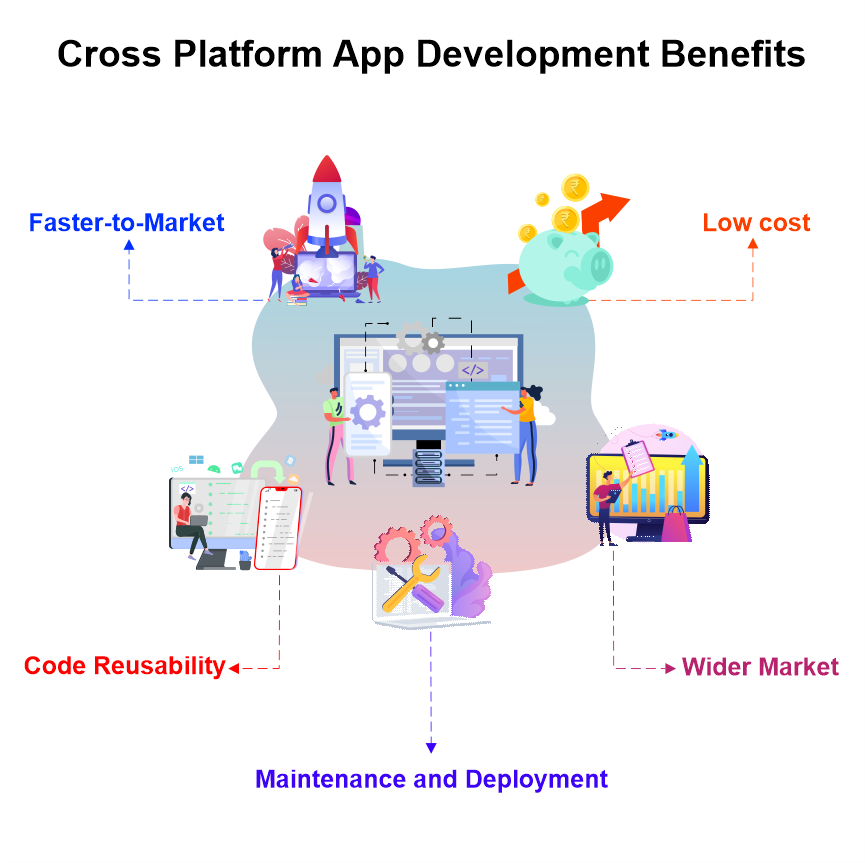Cross Platform App Development: A full Guide
Having a business app is the most convenient way to reach your audience because in this users don’t need to browse different pages of a website to check each page. If you’re looking to create an app that can run on multiple platforms, you’ll want to learn all you can about cross-platform app development. Mobile applications that can run across different operating systems are known as “cross-platform apps”. Without having to recode their mobile assets for each specific platform, developers can produce and distribute mobile assets that operate on both Android and iOS. There is no need for different coding for the various platforms or OSs because it follows the one-size-fits-all code.
The process of mobile application development for multiple platforms can be complex, but with the right knowledge and guidance, it’s possible to create a great product. In this blog post, we’ll provide you with a complete guide about cross-platform app development.
What is Cross-platform App Development?
An application that is created using a single codebase and designed to run on different mobile operating systems, such as Android and iOS, is known as a cross-platform mobile app. A cross-platform development tool that enables the software to be written once and then compiled for each platform can be used to accomplish this, as well as producing separate software versions for each platform. Common programming languages used by developers to create cross-platform apps include JavaScript, C#, and Dart. Cross-platform mobile apps are frequently built with native UI components to give them a native feel. Examples of well-known cross-platform mobile applications include: Instagram, Skype, Walmart, Google Ads, etc.
Advantages of Cross Platform Apps:
Code Reusability: One advantage of creating cross-platform mobile apps is the ability to reuse the code repeatedly. Instead of generating new code from scratch for platforms like Android and iOS, developers can reuse existing code. Because there is only one code base for several platforms, it only takes one set of updates to update the program across all platforms when functionality is added or removed. Because it minimizes repetition in the process of producing codes, this saves resources and time.
Low cost: Since you only need to design one codebase, creating cross-platform software might be more affordable than creating individual apps for each platform. The required effort can be reduced by more than half using a cross-platform framework. Due to the fact that you will only need to hire one development team with a certain set of talents rather than several teams with a variety of skill sets, you won't need to spend nearly as much as you would for native app development.
Wider Market: You are limiting your reach if you only allow one platform for the use of your app. One can target both the iOS and Android platforms by creating a single app. extending their reach as a result. The ability to deploy an app on numerous platforms thanks to cross-platform app development facilitates more thorough market research.
Maintenance and deployment: A single, universal app may run on all platforms thanks to cross-platform app development. As changes are made, this makes it simpler to maintain and deploy code. When adding or removing features, there is only one set of modifications needed to update the program across platforms. With only 20 to 50% of the development effort, you may create feature-rich cross-platform apps.
Faster-to-Market: A single codebase cross-development method shortens the time for development, deployment, and customization. It is simple for the developers to make little modifications in a single code if the app needs to be modified or altered. The time to market for the product is further shortened by these platforms' support for responsiveness, performance, and security, which streamlines and optimizes the process.

Disadvantages:
Compatibility: Cross-platform app developers struggle to keep their programs compatible with different devices and operating systems.
Complex integrations: Not all platform-specific features are integrated by cross-platform frameworks. Certain hardware integrations, such as the use of GPUs, may need knowledge of native app development.
Slower time for new features: When Apple or Google introduces a new feature for iOS or Android, updating cross-platform developed apps may take longer than updating native apps.
Frameworks for Cross-platform App Development
React Native: Facebook and Instagram both use React Native, making it the most widely used framework. The code-base of this cross-platform app framework is open-source and reusable. React Native is a wonderful option if you need to create a prototype quickly because it quickly converts source code to native elements.
Xamarin: Some of the most well-known app developers use the cross-platform development technology Xamarin. Microsoft acquired the independent, open-source, cross-platform Xamarin app development framework in 2016. Xamarin apps can be given a platform-specific technology boost to let them run as quickly as native apps while maintaining the look and feel of native apps.
Flutter: Another open source and cost-free cross-platform framework for building native Android and iOS interfaces is Flutter. The Flutter framework employs the Dart programming language, which is comparable to Java in syntax and makes use of object-oriented concepts. Java developers can work with it fast. Some well-known apps that have employed Flutter for cross-platform app development include Alibaba and Google Ads.
Conclusion:
Businesses must consider creating cross-platform apps to gain a competitive advantage in the challenging and competitive market of the modern digital age. Cross-platform app development is a wonderful option for businesses looking to have a quick MVP (minimum viable product) and get the product in front of as many users and devices as possible. Look no further than Career IT and Business Solutions Inc., a reputable mobile app development company in Edmonton, Canada, to obtain unique and outstanding apps that stand out in this market. With their commitment to quality, they are sure to deliver an app that meets your expectations.
